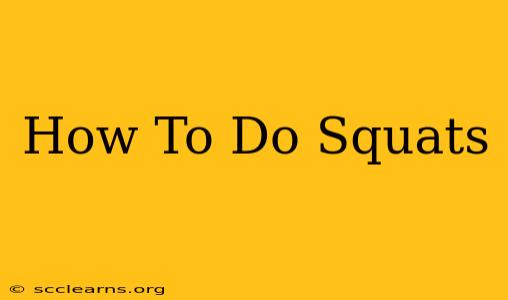Squats. The cornerstone of countless workout routines, the king of lower-body exercises. But are you doing them right? This comprehensive guide will walk you through the proper form, variations, common mistakes, and how to incorporate squats into your fitness regimen for maximum results.
Understanding the Benefits of Squats
Before we dive into the how-to, let's quickly cover why you should be doing squats. These aren't just another leg exercise; they deliver a powerhouse of benefits:
- Strength Building: Squats primarily target your quads, hamstrings, and glutes, building significant lower-body strength.
- Muscle Growth: Consistent squatting leads to increased muscle mass in your legs and glutes, contributing to a more toned physique.
- Improved Athletic Performance: Squats enhance athletic performance in various sports requiring explosive power and lower-body strength, such as running, jumping, and weightlifting.
- Increased Metabolism: More muscle mass means a higher resting metabolic rate, leading to increased calorie burning even at rest.
- Enhanced Core Strength: Proper squat form requires core engagement, improving stability and overall core strength.
Mastering the Basic Squat: A Step-by-Step Guide
Let's learn how to perform a perfect squat. Focus on these steps to ensure proper form and minimize injury risk:
- Stance: Stand with your feet slightly wider than shoulder-width apart, toes slightly pointed outward. Maintain a neutral spine – avoid arching your back.
- Lowering Down: Begin by pushing your hips back as if you're about to sit in a chair. Keep your chest up and core engaged throughout the movement. Lower your body until your thighs are parallel to the ground, or slightly below. Never let your knees cave inwards.
- The Ascent: Drive through your heels to return to the starting position. Squeeze your glutes at the top of the movement.
Important Considerations:
- Depth: Aim for at least parallel thighs to the ground. Going deeper will engage more muscle groups but requires increased flexibility.
- Knee Alignment: Your knees should track over your toes, preventing inward or outward pressure.
- Back Position: Maintain a straight back to avoid lower back pain.
Common Squat Mistakes to Avoid
- Rounding your back: This puts excessive strain on your spine. Focus on engaging your core and maintaining a neutral spine.
- Knees caving inward: This puts stress on your knees. Focus on pushing your knees outward, maintaining alignment with your toes.
- Heels lifting off the ground: This indicates insufficient ankle mobility. Work on improving ankle flexibility or use a slight heel lift.
- Looking up or down excessively: Keep your head up, looking forward. Excessive head movement can disrupt your balance.
Squat Variations to Challenge Yourself
Once you've mastered the basic squat, explore these variations to continue challenging your muscles and improving overall fitness:
- Goblet Squats: Hold a dumbbell or kettlebell close to your chest. This helps maintain upright posture.
- Overhead Squats: Hold a weight overhead (dumbbell or barbell). This increases core engagement and demands greater stability.
- Sumo Squats: Wider stance with toes pointed outwards, emphasizing inner thigh and glute activation.
- Jump Squats: Add an explosive jump at the top of the movement to build power.
Incorporating Squats into Your Workout Routine
Start with 2-3 sets of 8-12 repetitions of basic squats, 2-3 times a week. Gradually increase the weight, reps, or sets as you get stronger. Remember to listen to your body and rest when needed.
By following these guidelines and progressively challenging yourself, you'll be well on your way to reaping the many benefits of regular squatting. Remember, consistency is key! Stay dedicated, and you'll see significant improvements in your strength, fitness, and overall well-being.

